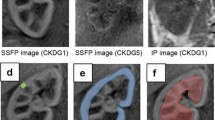Abstract
31P-magnetic resonance spectroscopy (31P-MRS) is a non-invasive tool to study high-energy phosphate (HEP) metabolism. We evaluate whether 31P-MRS can detect early changes in kidney HEP metabolism during a 6-month trial with Valsartan. Twenty consecutive stable and normotensive kidney-transplanted patients were enrolled. Nine of them received short-term low-dose Valsartan treatment (80 mg/day) for 6 months, while 11 controls received no medication. Kidney HEP metabolism was evaluated both at baseline and after treatment by 31P-MRS with a 1.5 T system (Gyroscan Intera Master 1.5 MR System; Philips Medical Systems, Best, The Netherlands). Valsartan-treated patients (n = 9) showed a significant increase in β-ATP/Pi ratio, a marker of kidney HEP metabolism (baseline = 1.03 ± 0.08 vs. 6 months = 1.26 ± 0.07, p = 0.03). In contrast, the β-ATP/Pi ratio in the control group (n = 11) did not change (baseline = 0.85 ± 0.10 vs. 6 months = 0.89 ± 0.08, ns). The improvement in the β-ATP/Pi ratio was not associated with a reduction in arterial blood pressure or in urinary albumin excretion. Kidney-localized 31P-MRS can detect early changes in kidney HEP metabolism during a short-term low-dose Valsartan treatment in stable normotensive kidney-transplanted patients.



Similar content being viewed by others
References
Fiorina P, Perseghin G, De Cobelli F et al (2007) Altered kidney graft high-energy phosphate metabolism in kidney-transplanted end-stage renal disease type 1 diabetic patients: a cross-sectional analysis of the effect of kidney alone and kidney-pancreas transplantation. Diabetes Care 30:597–603
McNamara R, Arias-Mendoza F, Brown TR (1994) Investigation of broad resonances in 31P NMR spectra of the human brain in vivo. NMR Biomed 7:237–242
Bretan PN Jr, Vigneron DB, Hricak H et al (1986) Assessment of renal preservation by phosphorus-31 magnetic resonance spectroscopy: in vivo normothermic blood perfusion. J Urol 136:1356–1359
Befroy DE, Shulman GI (2011) Magnetic resonance spectroscopy studies of human metabolism. Diabetes 60:1361–1369
Burtscher IM, Holtas S (2001) Proton magnetic resonance spectroscopy in brain tumours: clinical applications. Neuroradiology 43:345–352
Pomer S (1989) 31-phosphorus magnetic resonance spectroscopy—a new research instrument in urology. Determination of current status and outlook for clinical use. Urol A 28:223–230
Pomer S, Hull WE, Rohl L, Mohring K (1989) Assessment of renal viability by high-field phosphorus-31 magnetic resonance spectrometry. Transpl Proc 21:1268
Perseghin G, Fiorina P, De Cobelli F et al (2005) Cross-sectional assessment of the effect of kidney and kidney–pancreas transplantation on resting left ventricular energy metabolism in type 1 diabetic-uremic patients: a phosphorous-31 magnetic resonance spectroscopy study. J Am Coll Cardiol 46:1085–1092
Hene RJ, van der Grond J, Boer WH, Mali WP, Koomans HA (1994) Pre-transplantation assessment of renal viability with 31P magnetic resonance spectroscopy. Kidney Int 46:1694–1699
Seto K, Ikehira H, Obata T et al (2001) Long-term assessment of posttransplant renal prognosis with 31P magnetic resonance spectroscopy. Transplantation 72:627–630
Klemm A, Rzanny R, Funfstuck R et al (1998) 31P-magnetic resonance spectroscopy (31P-MRS) of human allografts after renal transplantation. Nephrol Dial Transpl 13:3147–3152
Boersema M, Rienstra H, van den Heuvel M et al (2009) Donor and recipient contribution to transplant vasculopathy in chronic renal transplant dysfunction. Transplantation 88:1386–1392
Opelz G, Wujciak T, Ritz E (1998) Association of chronic kidney graft failure with recipient blood pressure. Collaborative transplant study. Kidney Int 53:217–222
Raman GV (1991) Post transplant hypertension. J Hum Hypertens 5:1–6
Atkins RC, Zimmet P (2010) Diabetic kidney disease: act now or pay later. Acta Diabetol 47:1–4
Pan HZ, Zhang L, Guo MY et al (2009) The oxidative stress status in diabetes mellitus and diabetic nephropathy. Acta Diabetol 47:71–76
Cao Z, Cooper ME (2011) Efficacy of renin-angiotensin system (RAS) blockers on cardiovascular and renal outcomes in patients with type 2 diabetes. Acta Diabetol (Epub ahead of print)
Colvin RB (2003) Chronic allograft nephropathy. N Engl J Med 349:2288–2290
Fiorina P, Folli F, Zerbini G et al (2003) Islet transplantation is associated with improvement of renal function among uremic patients with type I diabetes mellitus and kidney transplants. J Am Soc Nephrol 14:2150–2158
Fioretto P, Steffes MW, Sutherland DE, Goetz FC, Mauer M (1998) Reversal of lesions of diabetic nephropathy after pancreas transplantation. N Engl J Med 339:69–75
Peng H, Wang C, Ye ZC et al (2009) How increased VEGF induces glomerular hyperpermeability: a potential signaling pathway of Rac1 activation. Acta Diabetol 47:57–63
Andres A, Morales E, Morales JM, Bosch I, Campo C, Ruilope LM (2006) Efficacy and safety of Valsartan, an angiotensin II receptor antagonist, in hypertension after renal transplantation: a randomized multicenter study. Transpl Proc 38:2419–2423
Acknowledgments
Paolo Fiorina is the recipient of: JDRF-Career Development Award, ASN Career Development Award, ADA mentor-based fellowship and MIUR grant: ("Staminali"RF-FSR-2008-1213704) and a TRP (Translational Research Program) grant. Roberto Bassi is supported by a ADA mentor-based fellowship.
Author information
Authors and Affiliations
Corresponding author
Rights and permissions
About this article
Cite this article
Fiorina, P., Bassi, R., Gremizzi, C. et al. 31P-magnetic resonance spectroscopy (31P-MRS) detects early changes in kidney high-energy phosphate metabolism during a 6-month Valsartan treatment in diabetic and non-diabetic kidney-transplanted patients. Acta Diabetol 49 (Suppl 1), 133–139 (2012). https://doi.org/10.1007/s00592-012-0369-2
Received:
Accepted:
Published:
Issue Date:
DOI: https://doi.org/10.1007/s00592-012-0369-2




